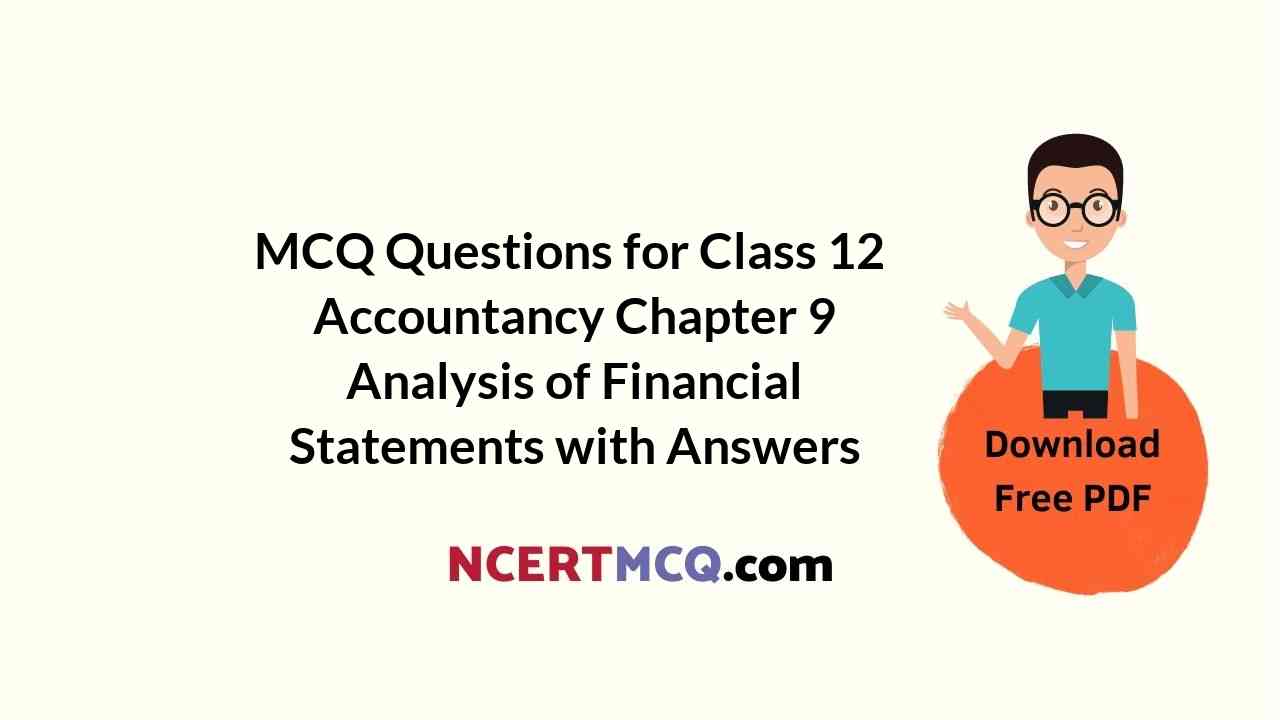Check the below NCERT MCQ Questions for Class 12 Accountancy Chapter 9 Analysis of Financial Statements with Answers Pdf free download. MCQ Questions for Class 12 Accountancy with Answers were prepared based on the latest exam pattern. We have provided Analysis of Financial Statements Class 12 Accountancy MCQs Questions with Answers to help students understand the concept very well.
Class 12 Accountancy Chapter 9 Analysis of Financial Statements MCQ With Answers
Accountancy Class 12 Chapter 9 MCQs On Analysis of Financial Statements
Financial Statement Analysis Class 12 MCQ Question 1.
Interpretation of Financial Statements includes:
(a) Criticisms and Analysis
(b) Comparison and Trend Study
(c) Drawing Conclusion
(d) All the above
Answer
Answer: (d) All the above
Financial Statement Analysis MCQ Question 2.
Horizontal Analysis is also known as :
(a) Dynamic Analysis
(b) Structural Analysis
(c) Static Analysis
(d) None of these
Answer
Answer: (a) Dynamic Analysis
Analysis Of Financial Statements Class 12 MCQ Question 3.
Vertical Analysis is also known as :
(a) Static Analysis
(b) Dynamic Analysis
(c) Structural Analysis
(d) None of these
Answer
Answer: (a) Static Analysis
Financial Statement Analysis MCQ Class 12 Question 4.
Comparative Statements are also known as :
(a) Dynamic Analysis
(b) Horizontal Analysis
(c) Vertical Analysis
(d) External Analysis
Answer
Answer: (b) Horizontal Analysis
MCQ On Financial Statement Analysis Class 12 Question 5.
Common-size Statement are also known as:
(a) Dynamic Analysis
(b) Horizontal Analysis
(c) Vertical Analysis
(d) External Analysis
Answer
Answer: (c) Vertical Analysis

Analysis Of Financial Statements MCQ Question 6.
The most commonly used tools for financial analysis are:
(a) Comparative Statements
(b) Common-size Statement
(c) Accounting Ratios
(d) All the above
Answer
Answer: (d) All the above
Financial Analysis Is Useful For MCQ Question 7.
The analysis of financial statement by a shareholder is an example of:
(a) External Analysis
(b) Internal Analysis
(c) Vertical Analysis
(d) Horizontal Analysis
Answer
Answer: (a) External Analysis
MCQ Of Financial Statement Analysis Question 8.
For calculating trend percentages any year is selected as:
(a) Current year
(b) Previous year
(c) Base year
(d) None of these
Answer
Answer: (c) Base year
Question 9.
Tools for comparison of financial statements are :
(a) Comparative Balance Sheet
(b) Comparative Income Statement
(c) Common-size Statement
(d) All the above
Answer
Answer: (d) All the above
Question 10.
Trend ratios and trend percentage are used in :
(a) Dynamic analysis
(b) Static analysis
(c) Horizontal analysis
(d) Vertical Analysis
Answer
Answer: (c) Horizontal analysis
Question 11.
Comparative Financial Statements show:
(a) Financial position of a concern
(b) Earning capacity of a concern
(c) Both of them
(d) None of these
Answer
Answer: (c) Both of them
Question 12.
Comparative financial analysis process shows the comparison between the items of which statement:
(a) Balance Sheet
(b) Profit & Loss Statement
(c) (a) and (b) both
(d) None of these
Answer
Answer: (c) (a) and (b) both
Question 13.
Which of these are not the method of financial statement analysis ?
(a) Ratio Analysis
(b) Comparative Analysis
(c) Trend Analysis
(d) Capitalisation Method
Answer
Answer: (d) Capitalisation Method
Question 14.
Common-size financial statements are mostly prepared:
(a) In proportion
(b) In percentage
(c) (a) and (b) both
(d) None of these
Answer
Answer: (b) In percentage
Question 15.
Tangible assets of company increased from T 4,00,000 to T 5,00,000. What is the percentage of change ?
(a) 20%
(b) 25%
(c) 33%
(d) 50%
Answer
Answer: (b) 25%
Question 16.
A company’s shareholders fund was 7 8,00,000 in the year 2015. It because 7 12,00,000 in the year 2016. What is percentage of change ?
(a) 100%
(b) 25%
(c) 50%
(d) 33.3%
Answer
Answer: (c) 50%
Question 17.
A company’s net sales are ₹ 15,00,000; cost of sales is ₹ 10,00,000 and indirect expenses are ₹ 3,00,000, the amount gross profit will be:
(a) ₹ 13,00,000
(b) ₹ 5,00,000
(c) ₹ 2,00,000
(d) ₹ 12,00,000
Answer
Answer: (c) ₹ 2,00,000
Question 18.
Sales less Cost of goods sold is called :
(a) Operating Profit
(b) Gross Profit
(c) Net Profit
(d) Total Profit
Answer
Answer: (b) Gross Profit
Question 19.
If total assets of a firm are 7 12,00,000 and its non of non-current assets to total assets ?
(a) 50%
(b) 75%
(c) 25%
(d) 80%
Answer
Answer: (b) 75%
Question 20.
If total assets of a firm are 7 10,00,000 and its non-current assets are 7 6,00,000, what will be the percentage of current assets on total assets ?
(a) 60%
(b) 50%
(c) 40%
(d) 30%
Answer
Answer: (c) 40%
Question 21.
In a common-size Balance Sheet, total equity and liabilities are assumed to be equal to :
(a) 1,000
(b) 100
(c) 10
(d) 1
Answer
Answer: (b) 100
Question 22.
Break-even point refers to that point where :
(a) Total Costs are more than Total Sales
(b) Total Costs are less than Total Sales
(c) Total Costs are half of the Total Sales
(d) Total Cost are equal to total sales
Answer
Answer: (d) Total Cost are equal to total sales
Question 23.
Payment of Income Tax is considered as :
(a) Direct Expenses
(b) Indirect Expenses
(c) Operating Expenses
(d) None of these
Answer
Answer: (b) Indirect Expenses
Question 24.
Vertical Analysis is also known as :
(a) Fluctuation Analysis
(b) Static Analysis
(c) Horizontal Analysis
(d) None of these
Answer
Answer: (b) Static Analysis
Question 25.
Financial analysis is useful:
(a) For Investors
(b) For Shareholders
(c) For Debenture holders
(d) All the above
Answer
Answer: (d) All the above
Question 26.
Analysis of financial statements involve :
(a) Trading A/c
(b) Profit & Loss statement
(c) Balance Sheet
(d) All the above
Answer
Answer: (d) All the above
Question 27.
Financial analysis is significant because it:
(a) Ignores qualitative aspect
(b) Judges operational efficiency
(c) Suffers from the limitations of financial statements
(d) It is affected by personal ability and bias of the analysis
Answer
Answer: (b) Judges operational efficiency
Question 28.
What is shown by the Income Statement ?
(a) Accuracy of books of accounts
(b) Profit or loss of a certain period
(c) Balance of Cash Book
(d) None of these
Answer
Answer: (b) Profit or loss of a certain period
Question 29.
What is shown by Balance Sheet ?
(a) Accuracy of books of accounts
(b) Profit or loss of a specific period
(c) Financial position on a specific date
(d) None of the above
Answer
Answer: (c) Financial position on a specific date
Question 30.
Which of the following is the purpose or objective of financial analysis ?
(a) To assess the current profitability of the firm
(b) To measure the solvency of the firm
(c) To assess the short-term and long-term liquidity position of the firm
(d) All the above
Answer
Answer: (d) All the above
Question 31.
Out of the following which parties are interested in financial statements ?
(a) Managers
(b) Financial Institutions
(c) Creditors
(d) All the these
Answer
Answer: (d) All the these
Question 32.
Which of the following is not a limitations of financial statement analysis ?
(a) To measure the financial strength
(b) Affected by window-dressing
(c) Do not reflect changes in price level
(d) Lack of Qualitative Analysis
Answer
Answer: (a) To measure the financial strength
Question 33.
Break-even Analysis shows:
(a) Relationship between cost and sales
(b) Relationship between production and purchases
(c) Relationship between cost and revenue
(d) None of these
Answer
Answer: (a) Relationship between cost and sales
Question 34.
Which of the following shows the actual financial position of n enterprise ?
(a) Fund Flow
(b) Balance Sheet
(c) P & L A/c
(d) Ratio Analysis
Answer
Answer: (b) Balance Sheet
Question 35.
The financial statements of a business enterprise include:
(a) Balance Sheet
(b) Profit & Loss Account
(c) Cash Flow Statement
(d) All the above
Answer
Answer: (d) All the above

Question 36.
An annual report is issued by company to its :
(a) Directors
(b) Auditors
(c) Shareholders
(d) Management
Answer
Answer: (c) Shareholders
Question 37.
Balance Sheet provides information about financial position of the enterprise :
(a) At a Point of Time
(b) Over a Period of Time
(c) For a Period of Time
(d) None of the above
Answer
Answer: (a) At a Point of Time
Question 38.
Profit & Loss Account is also called :
(a) Balance Sheet
(b) Income Statements
(c) Operating Profit
(d) Investment
Answer
Answer: (b) Income Statements
Question 39.
Which of the following statement is correct ?
(a) Assets = Liabilities + Shareholders funds
(b) Assets = Total funds
(c) Assets = Funds of outsiders .
(d) None of the above
Answer
Answer: (a) Assets = Liabilities + Shareholders funds
Question 40.
In which meeting of company directors report is presented ?
(a) Directors Meeting
(b) Annual General Meeting
(c) Manager’s Meeting
(d) All of the above
Answer
Answer: (b) Annual General Meeting
Question 41.
On the basis of process, which of the following is the type of financial analysis ?
(a) Horizontal Analysis
(b) Vertical Analysis
(c) Ratio Analysis
(d) (a) and (b) both
Answer
Answer: (d) (a) and (b) both
Question 42.
Which Of the following is limitation of financial analysis ?
(a) Window-dressing
(b) Basis of Valuation
(c) Lack of Accuracy
(d) All the above
Answer
Answer: (d) All the above
Question 43.
Which of the following is not the limitations of financial analysis ?
(a) Lack of Accuracy
(b) Based on Historical facts
(c) Basis of Valuation
(d) Information of Profit and Loss
Answer
Answer: (d) Information of Profit and Loss
Question 44.
When Financial Statements of two or more organisations are analysed, it is called :
(a) Intra-firm Analysis
(b) Inter-firm Analysis
(c) Vertical Analysis
(d) None of these
Answer
Answer: (b) Inter-firm Analysis
Question 45.
Which of the following statement correct ?
(a) Retained Earnings = Total Income
(b) Retained Earnings = Revenue-expenses
(c) Retained Earnings = Gross Profit
(d) None of the above
Answer
Answer: (b) Retained Earnings = Revenue-expenses
Question 46.
Which of the following is a type of Financial Analysis on the basis of material used ?
(a) Internal Analysis
(b) External Analysis
(c) Internal Audit
(d) Both (a) and (b)
Answer
Answer: (d) Both (a) and (b)
We hope the given NCERT MCQ Questions for Class 12 Accountancy Chapter 9 Analysis of Financial Statements with Answers Pdf free download will help you. If you have any queries regarding CBSE Class 12 Accountancy Analysis of Financial Statements MCQs Multiple Choice Questions with Answers, drop a comment below and we will get back to you soon.
Class 12 Accountancy MCQ:
- Accounting for Not for Profit Organisation Class 12
- Accounting for Partnership: Basic Concepts Class 12
- Reconstitution of Partnership Firm: Admission of a Partner Class 12
- Reconstitution of Partnership Firm: Retirement / Death of a Partner Class 12
- Dissolution of a Partnership Firm Class 12
- Accounting for Share Capital Class 12
- Issue and Redemption of Debentures Class 12
- Financial Statements of a Company Class 12
- Analysis of Financial Statements Class 12
- Accounting Ratios Class 12
- Cash Flow Statement Class 12
